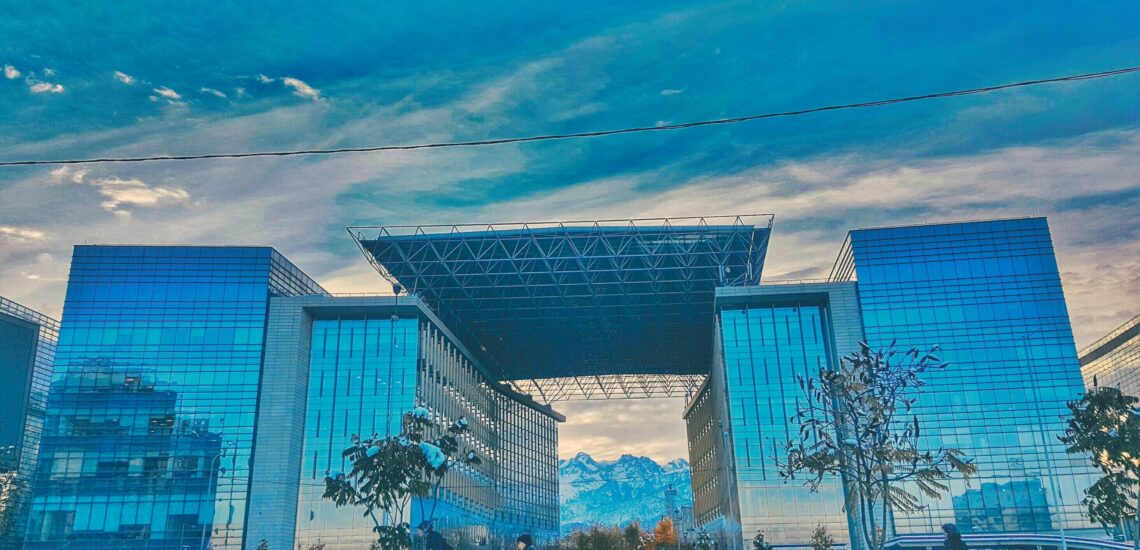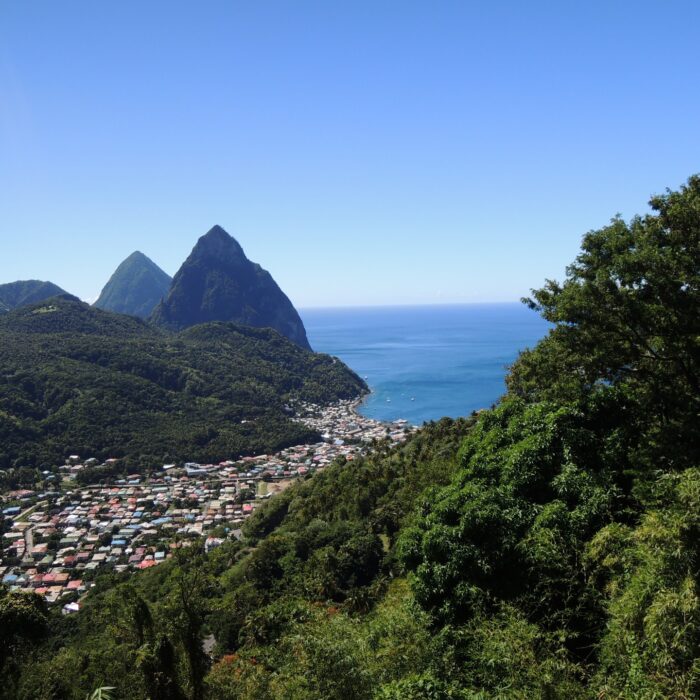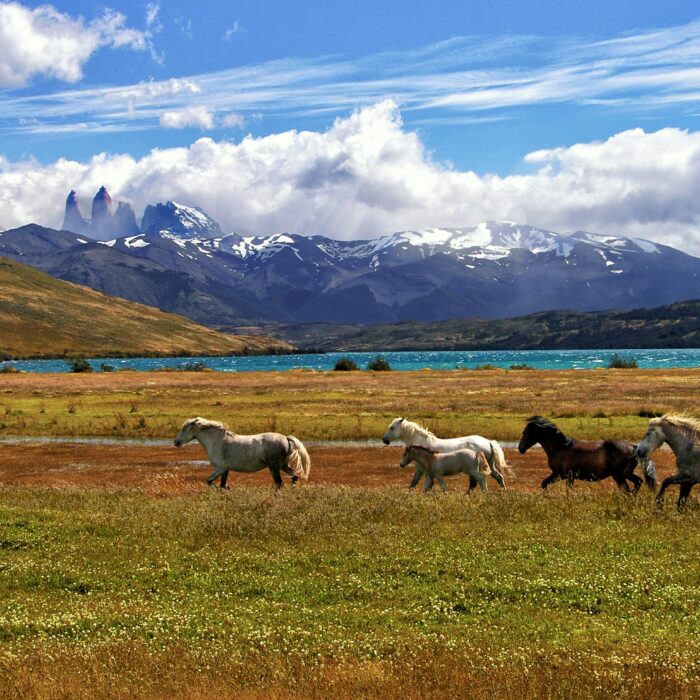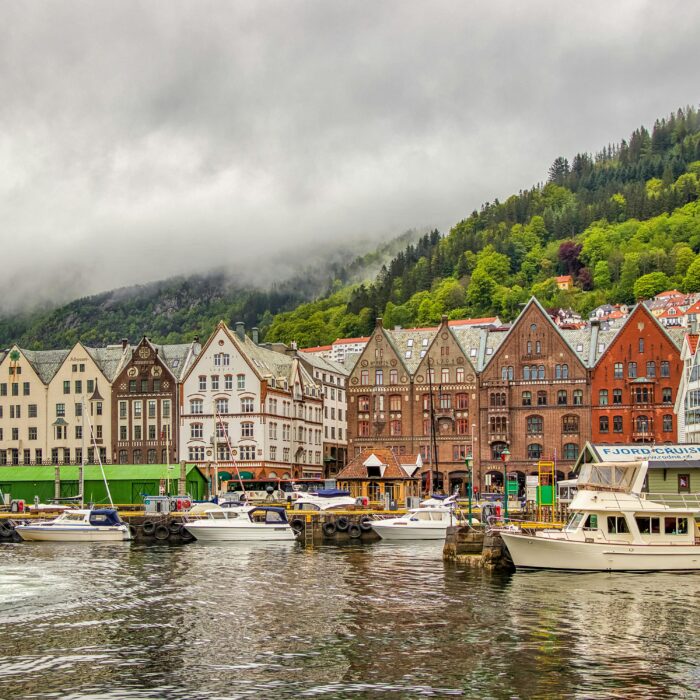Kazakhstan is the ninth-largest country in the world, stretching from Europe to Central Asia. Despite its size, it’s sparsely populated—perfect for those seeking open landscapes and off-the-beaten-path adventures.
In Almaty, explore mountain trails to Big Almaty Lake, then relax in the city’s lively cafés. In Astana (Nur-Sultan), admire futuristic architecture like the Bayterek Tower and Khan Shatyr, while nearby ethnographic villages offer a glimpse into nomadic traditions.
To the south, Turkistan’s UNESCO-listed mausoleum and the Silk Road cities of Shymkent and Taraz reveal Kazakhstan’s rich history. Nature lovers can hike Charyn Canyon or explore Aksu-Zhabagly Reserve, home to rare wildlife and wildflowers.
From ancient trade routes to modern skylines, Kazakhstan offers a unique blend of cultures, landscapes, and experiences.
Best Cities to Visit
Astana
Astana isn’t your typical city break. It’s weird, windy, and absolutely fascinating. One moment you’re walking past a giant glass pyramid, the next you’re standing inside the world’s biggest tent-shaped mall with a beach on the top floor. Yes, a beach – in a place where winters hit –30°C.
This is a city that doesn’t do “ordinary.” Locals call it “the city of tomorrow,” and it really does feel like someone let an architect dream freely. The Bayterek Tower – a golden orb on a white lattice – looks like something from a video game. You can go up and see the whole city laid out like a model on the steppe.
But Astana isn’t just for show. There’s a ton to do. The National Museum has everything from ancient nomadic gear to glowing modern art. The Astana Opera is ridiculously grand and tickets are affordable, even for world-class performances. And the EXPO site is perfect if you’re into science, tech, or just cool interactive exhibits (the giant glass sphere is seriously impressive).
Need a break? Stroll along Nurzhol Boulevard, rent a bike by the Ishim River, or grab a plate of steaming lagman and watch the city light up at night. You’ll also find street food, cozy cafés, and plenty of quiet corners to just sit and take in the surreal skyline.
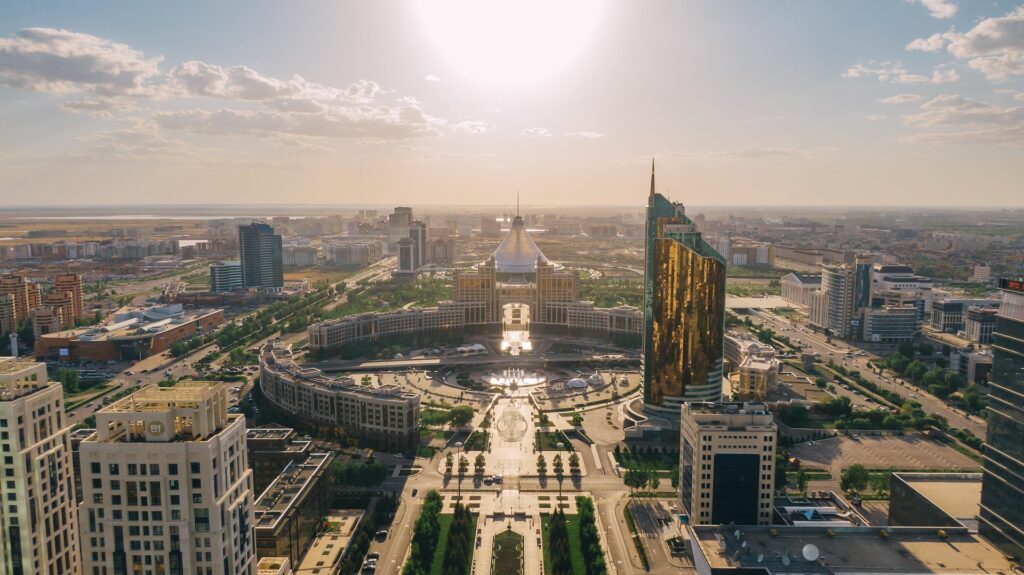
Almaty
If you want a city that feels alive but still lets you breathe, head to Almaty. Tucked right up against the snowy Tian Shan mountains, it’s green, walkable, and full of charm. Think wide tree-lined streets, outdoor cafés, and a backdrop so beautiful it barely looks real.
People come here to feel Kazakhstan. Start your morning with strong coffee and fresh samsa at a local bakery, then ride the cable car up to Kok Tobe Hill – you’ll get epic views, a mini amusement park, and maybe even spot a mountain goat or two.
Back in town, don’t miss the Zenkov Cathedral, a rainbow-colored church built entirely of wood – with no nails. It’s right next to Panfilov Park, where locals hang out, snack on sunflower seeds, and play chess in the shade. For a taste of everyday life, wander the Green Bazaar – you’ll find dried fruits, spices, fresh produce, and friendly banter in Russian, Kazakh, and a dozen other languages.
Almaty is also your launchpad to jaw-dropping day trips. In under two hours, you can be hiking to Big Almaty Lake, standing on the edge of Charyn Canyon, or skiing at Shymbulak, a high-altitude resort with killer views.
This southern city buzzes with life: street vendors shout over crates of pomegranates, cafés spill out onto sidewalks, and the scent of cumin and grilled meat hangs in the air. It’s colorful, chaotic, and full of heart.
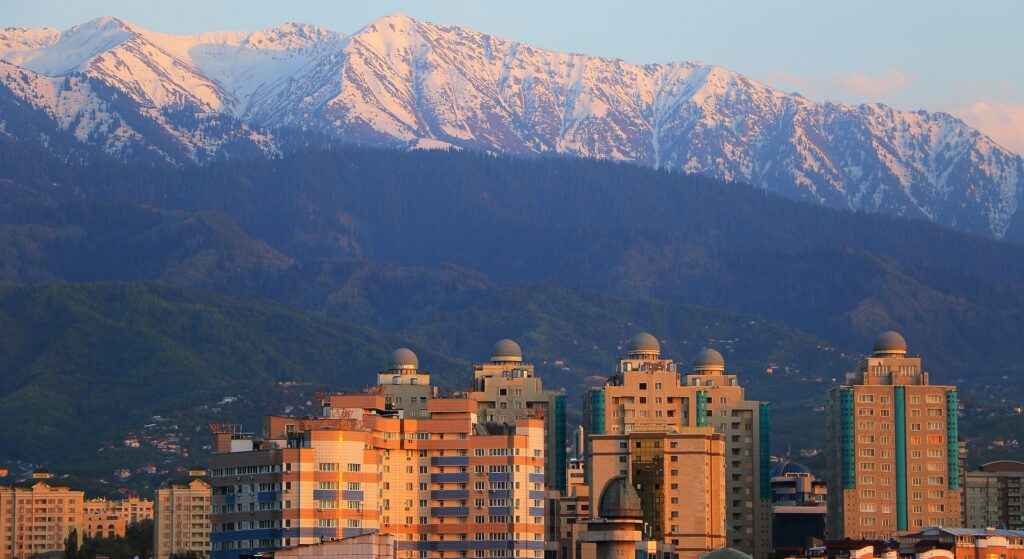
Shymkent
Come here if you want to experience a more down-to-earth Kazakhstan. Wander through local bazaars packed with spices, handmade fabrics, and Uzbek-style sweets. Try shashlik straight off the coals or sip green tea in a shady courtyard. The vibe is warm, welcoming, and proudly local.
Shymkent is also a perfect base for exploring the region’s deep roots. Just outside the city, Sayram – older than Shymkent itself – offers ancient mausoleums, Islamic shrines, and the quiet feel of a place that’s seen over a thousand years of history. Nature lovers should head to Aksu-Zhabagly Nature Reserve, the oldest in Central Asia.
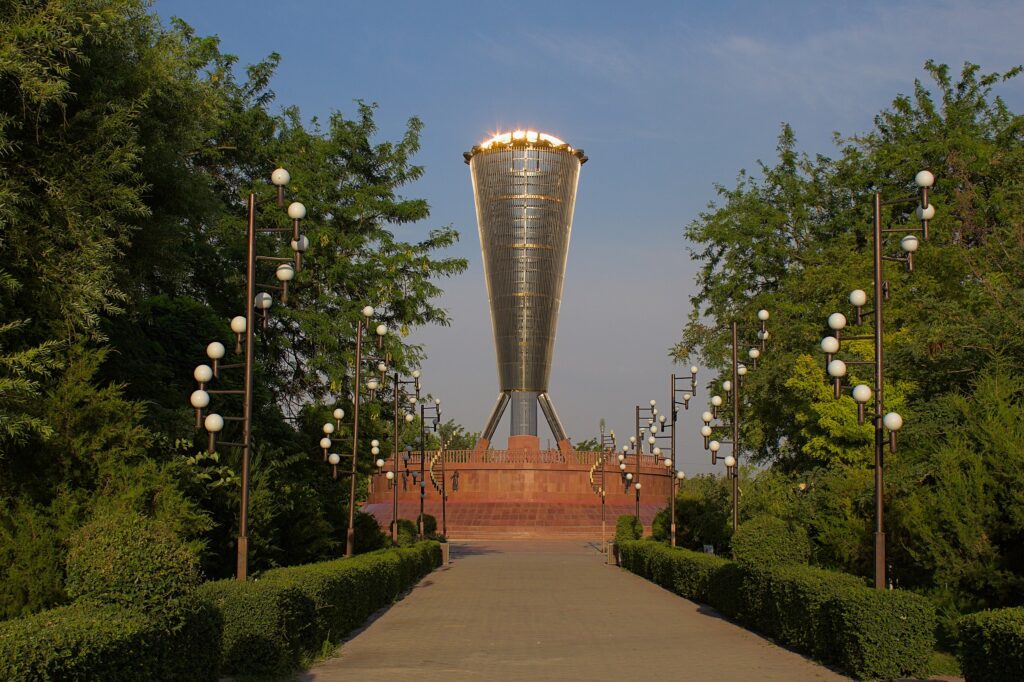
Turkistan
For over 500 years, this has been one of Central Asia’s most important spiritual centers, drawing pilgrims from across the region. When you walk its wide plazas and sandstone paths, it feels like stepping into a different rhythm of time.
At the heart of it all is the Mausoleum of Khoja Ahmed Yasawi – a massive, turquoise-domed complex built by order of Tamerlane in the 14th century. It’s more than a UNESCO site; it’s a living place of worship, where locals come to pray, reflect, and honor one of Kazakhstan’s most beloved Sufi poets.
Why go? Because Turkistan offers something rare – a mix of deep spirituality, rich history, and modern calm. Whether you’re religious or not, it’s a place that invites you to slow down, look closer, and listen to stories that have echoed across centuries.
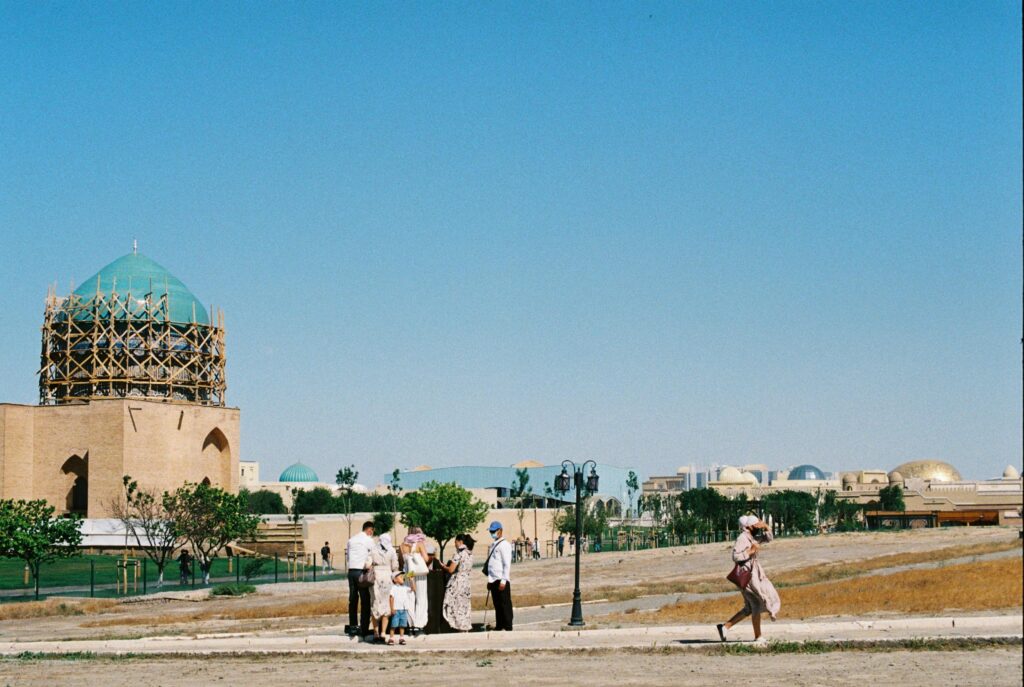
Karaganda
Karaganda doesn’t try to hide its history – you see it in the heavy Soviet architecture, the memorials, and the wide, quiet streets. Once a major center of coal mining and Gulag labor camps, the city carries a weight that you can feel – but it also tells a story of resilience, reinvention, and quiet creativity.
Start with the Karlag Museum, located in a former NKVD building. It’s haunting, powerful, and essential – offering a raw look at the Gulag system that shaped the region and scarred generations. But that’s only one layer of Karaganda.
Today, the city is home to thriving universities, jazz bars, street murals, and small experimental theaters. You’ll find sculpture parks, student cafés, and a surprising amount of local art that feels bold and personal.
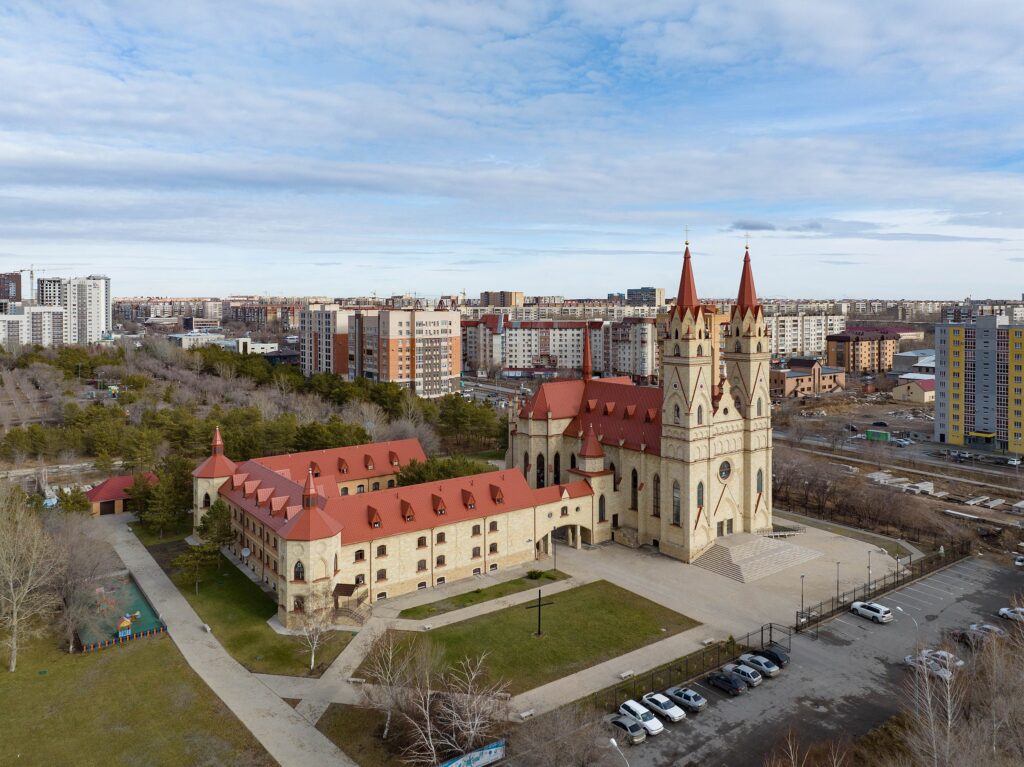
Aktau
Few places in the world let you swim in the sea and hike through alien-looking canyons on the same trip – but Aktau does exactly that. Perched on the Caspian coast, this laid-back city is Kazakhstan’s window to the west, where turquoise water meets dry desert cliffs.
Aktau is the perfect base for exploring the Mangystau Region, one of Kazakhstan’s most surreal landscapes. Think Bozjyra Canyon, with its razor-sharp ridges and alien rock formations, or underground mosques carved into limestone, like Beket-Ata – spiritual, silent, and unlike anything you’ve seen before.
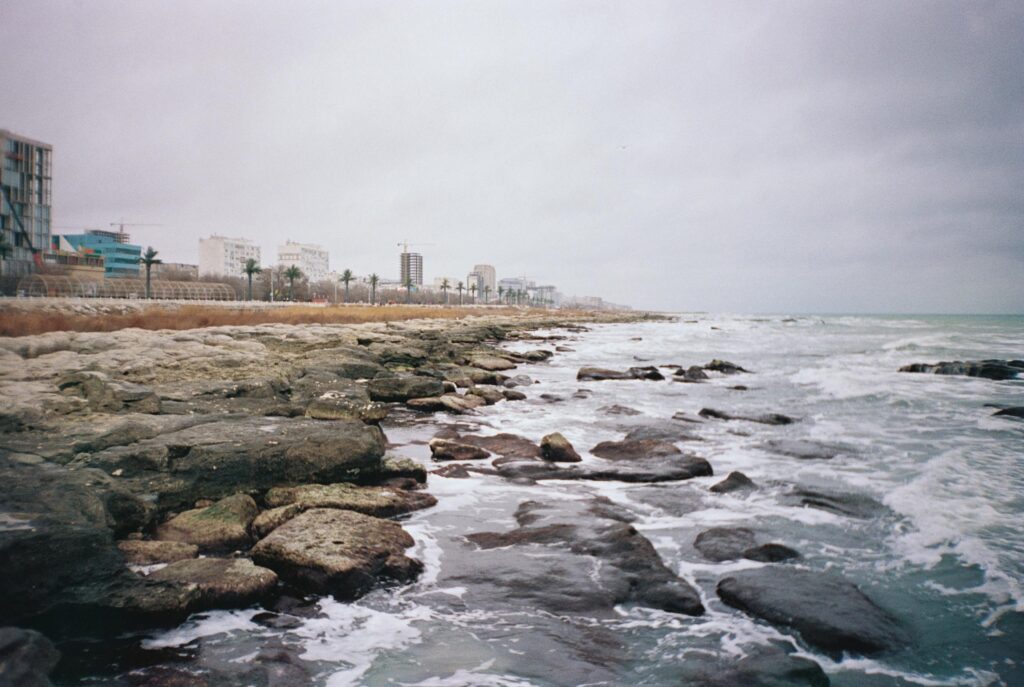
Best Natural Wonders
Charyn Canyon
If you’ve ever dreamed of walking through a real-life fantasy landscape, Charyn Canyon delivers. Just a 3-hour drive from Almaty, this natural wonder stuns with rust-red cliffs, twisted rock towers, and deep, echoing gorges that look like they belong on another planet.
The most famous route is the Valley of Castles trail – a winding path between towering sandstone formations that resemble ancient fortresses. It’s an easy hike, but every turn feels cinematic. Come at golden hour and watch the canyon walls glow like fire.
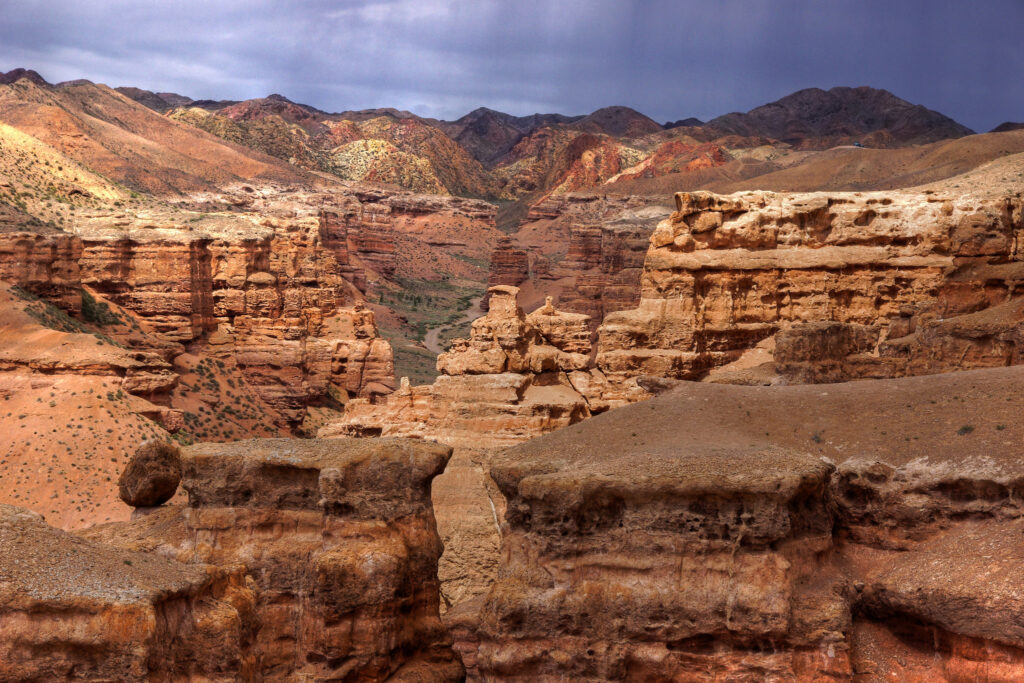
Big Almaty Lake
Tucked high in the Tian Shan Mountains, just an hour’s drive from Almaty, Big Almaty Lake looks almost unreal – a glowing bowl of turquoise water surrounded by jagged, snow-dusted peaks. At over 2,500 meters above sea level, the air is crisp, the silence deep, and the view unforgettable.
You can’t swim here – it’s a protected water source – but you won’t want to. This is a place to hike, breathe, and just take it all in. Depending on the season, the lake shifts from icy blue to vivid green, with the best colors showing in late spring and early autumn.
The road up winds through pine forests and steep slopes, with occasional lookout points perfect for a photo stop. If you’re lucky, you might spot golden eagles overhead or marmots scurrying across the rocks.
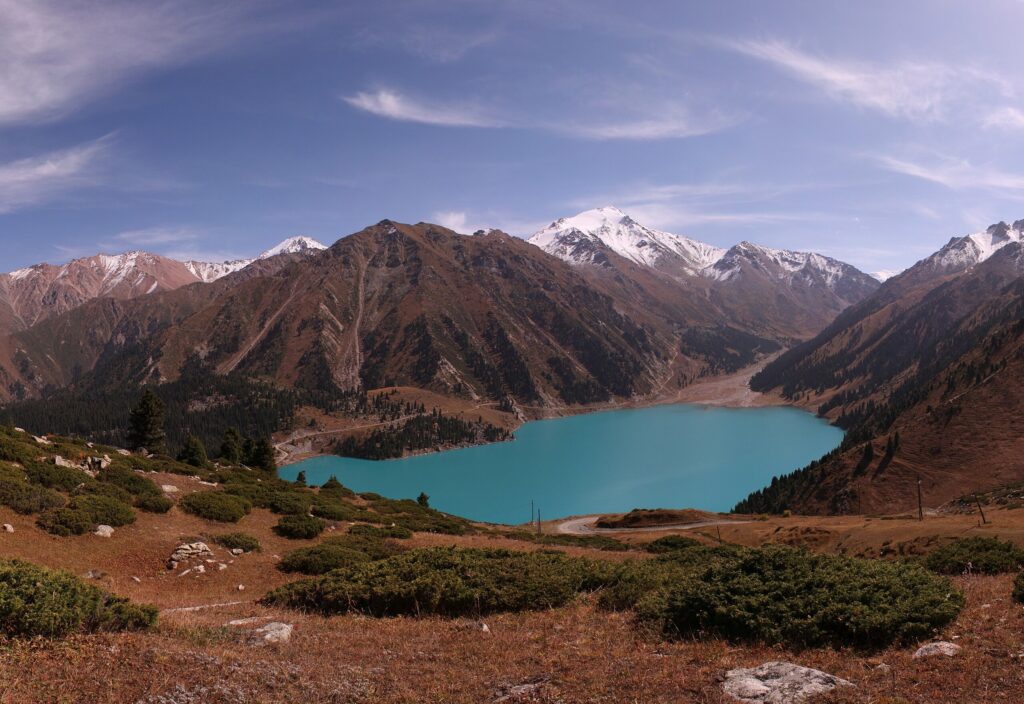
Altai Mountains
Bordering Russia, China, and Mongolia, the region isn’t just rich in nature – it’s a cultural crossroads, where Turkic myths, shamanic traditions, and ancient petroglyphs still echo through the valleys.
Trekkers come here for multi-day hikes to places like Lake Markakol or the Rakhmanov Springs, where crystal-clear waters meet dense taiga. Birdwatchers can spot golden eagles, black storks, and rare owls, while others simply come to disconnect and breathe air that feels like it hasn’t changed in centuries.
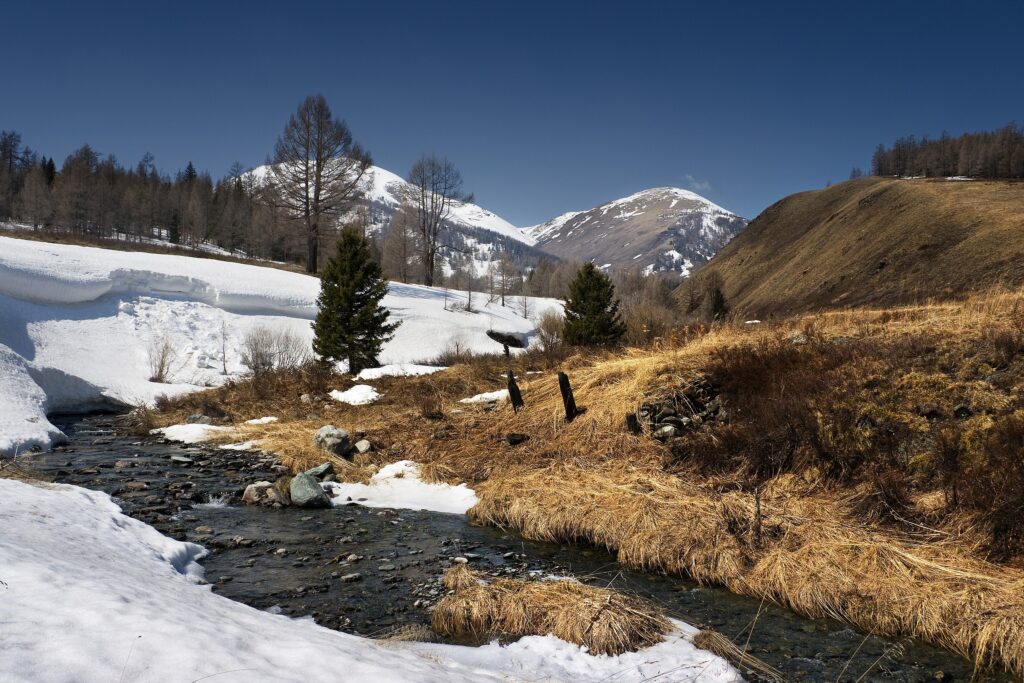
Lake Kaindy
Cold, clear, and eerily beautiful, its surface is pierced by the ghostly trunks of spruce trees rising straight from the water. They’re not dead – just frozen in time.
Formed by an earthquake-triggered landslide in 1911, the lake flooded a pine forest, and thanks to the icy temperatures, the trees remain almost perfectly preserved underwater. From above, it looks surreal. Up close, it’s quiet, haunting, and completely unforgettable.
You can hike through the surrounding forest or kayak across the still surface – just you, the trees, and the mirror-like water. In autumn, the contrast of golden leaves and blue water is especially stunning.
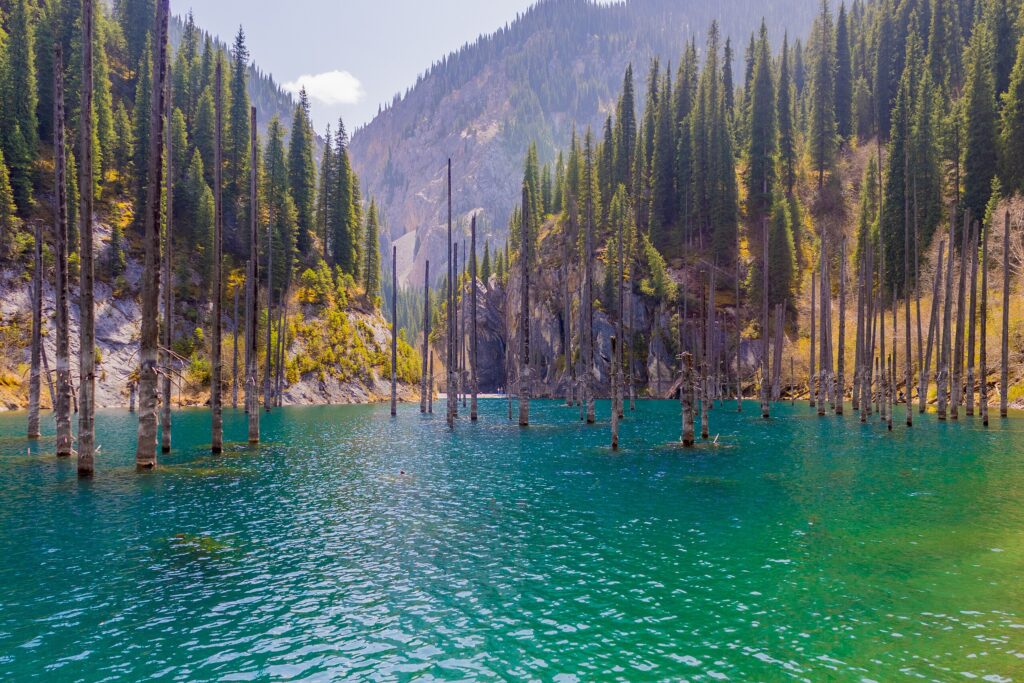
Kolsai Lakes
Tucked near the Kyrgyz border, this trio of crystal-clear lakes sits like stepping stones between forested slopes and rugged peaks – a paradise for hikers, campers, and anyone craving wild beauty without the crowds.
The first lake is easy to reach by car and perfect for a peaceful picnic or boat ride. But the real magic begins when you head deeper. A 3–4 hour hike (or horseback ride) takes you to the second lake, winding through pine forests, alpine meadows, and rocky ridges with sweeping views.
Camp by the water, fish for trout, or just sit in silence while the sun sets behind the mountains. Few places in Kazakhstan feel this remote yet so accessible.
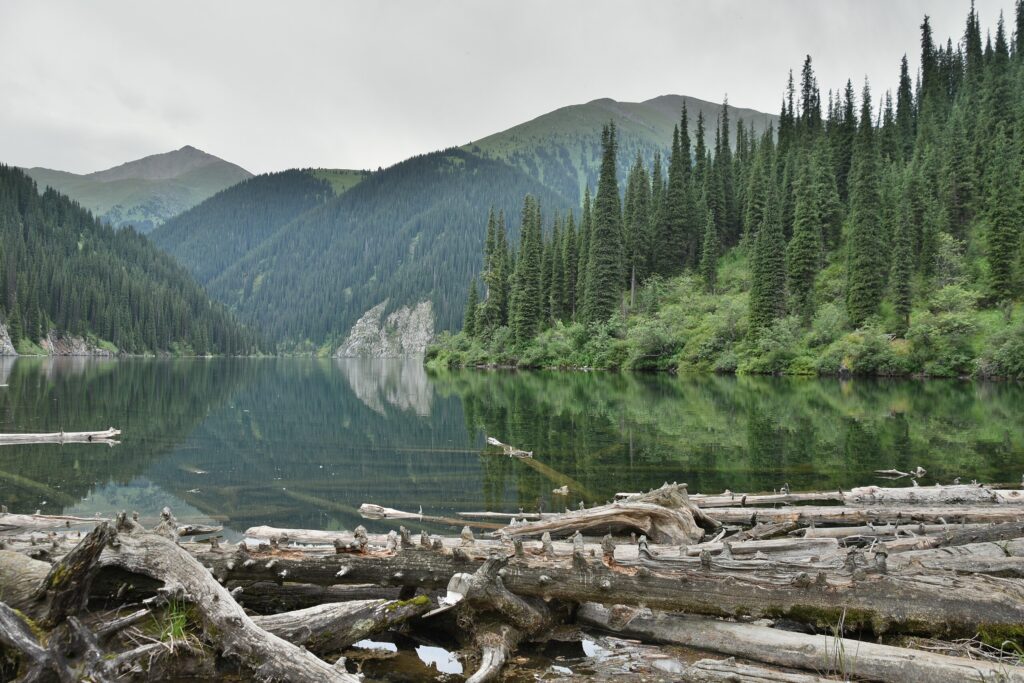
Bozzhyra Canyon (Mangystau)
Hidden deep in the Mangystau region, this surreal landscape stuns with razor-sharp white cliffs, sculpted ridges, and endless desert horizons that seem to stretch into another dimension.
The silence here is total. No roads, no crowds – just wind, rock, and sky. The most iconic view? Two jagged limestone peaks rising like alien fangs from the canyon floor, glowing gold at sunrise and ghostly white by moonlight.
Getting here isn’t easy – you’ll need a 4WD vehicle and a good sense of direction – but that’s part of the thrill. It’s remote, wild, and completely untouched. There are no fences, no signs – just raw nature and the freedom to explore.
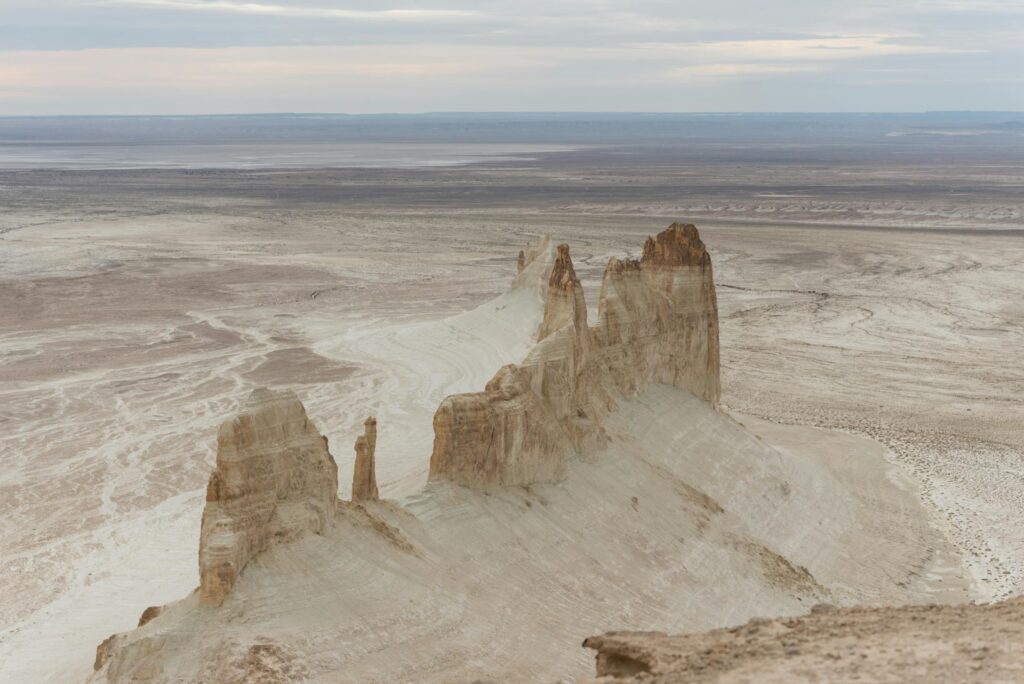
Hidden Gems of Kazakhstan
Tamgaly Petroglyphs
Just a few hours northwest of Almaty lies one of Kazakhstan’s most quietly powerful sites – the Tamgaly Petroglyphs. Scattered across sunbaked canyon walls, over 5,000 carvings tell stories from the Bronze Age, capturing the lives, rituals, and beliefs of early nomadic peoples.
You’ll see scenes of dancing figures, hunters, wild animals, and mysterious sun-headed deities – symbols of a world where nature, spirit, and survival were deeply connected. Some carvings are bold and clear, others faint with age, but all carry the same quiet weight of time.
The landscape itself adds to the magic: rocky hills, dry grass, and total stillness. It’s not a crowded place – you might have it all to yourself, with only the wind and the past for company.
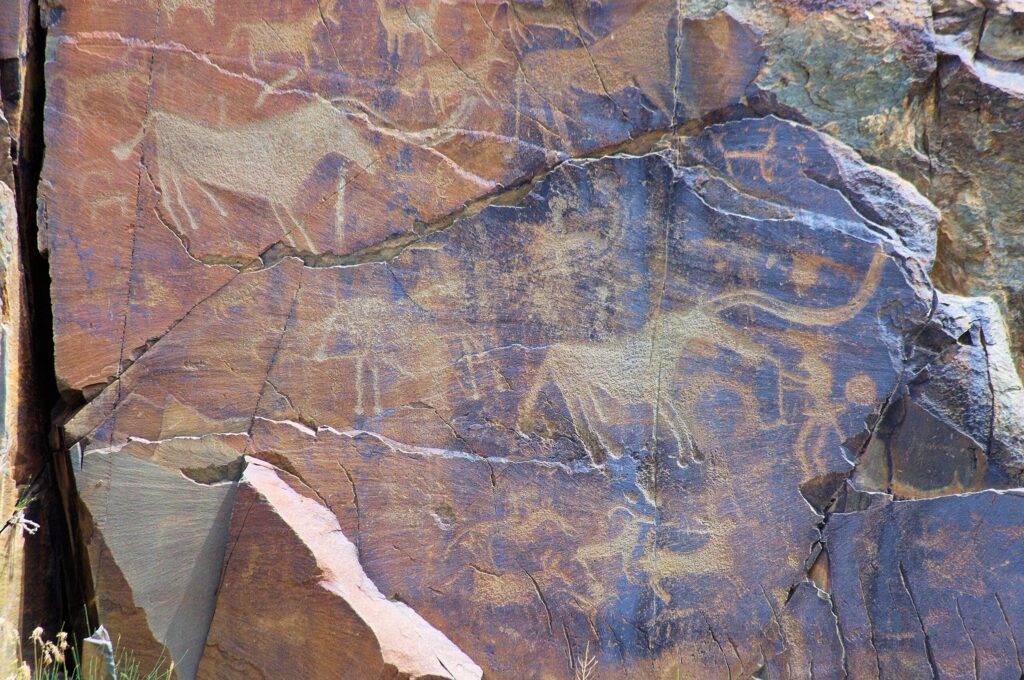
Underground Mosques of Mangystau
Carved straight into rock, sites like Beket-Ata and Shakpak-Ata have served as spiritual refuges for centuries. Pilgrims still journey here on foot, some traveling for days across the steppe to pray in these cool, shadowed chambers. Inside, you’ll find simple stone altars, flickering candles, and a silence that speaks louder than words.
Each mosque carries its own legends, tied to Sufi saints and ancient rituals. Getting there requires effort – rough roads, remote terrain – but that only adds to the sense of discovery.
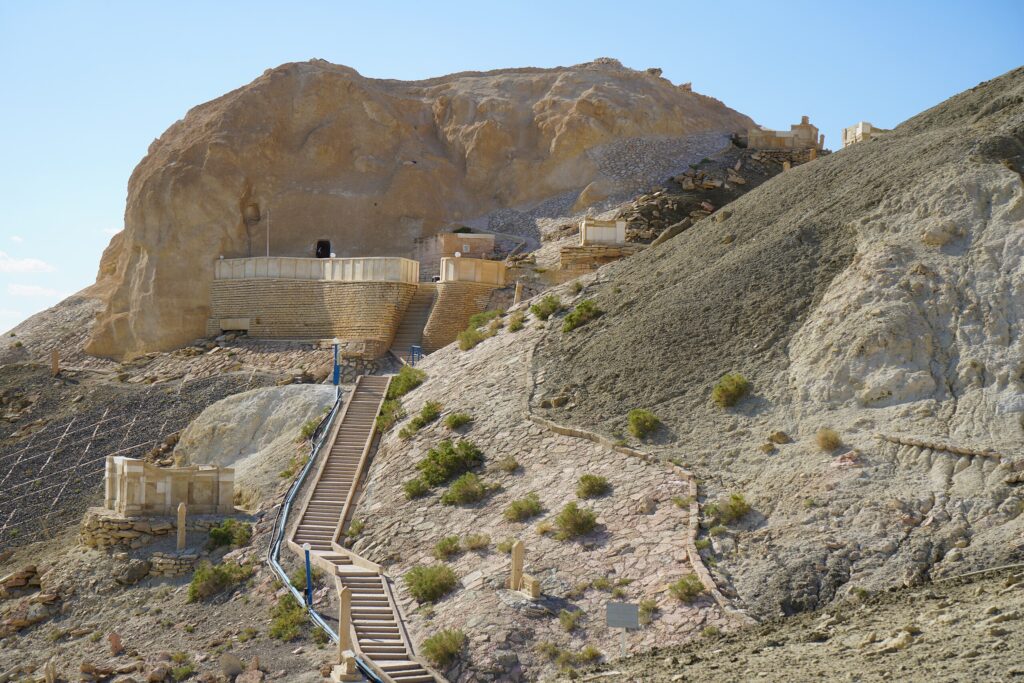
Zharkent Mosque
Tucked near the Chinese border in southeastern Kazakhstan, the Zharkent Mosque is like nothing else in the country. Built in the late 1800s by Chinese craftsmen, it looks more like a pagoda than a traditional mosque – with sweeping wooden eaves, dragon motifs, and bright hand-painted details that feel straight out of a fairytale.
Step inside and you’ll find intricate floral patterns, vivid murals, and a prayer hall unlike any you’ve seen – all crafted without a single nail. It’s a striking example of cultural fusion, where Islamic tradition meets Chinese design, reflecting centuries of trade, migration, and exchange along the Silk Road.
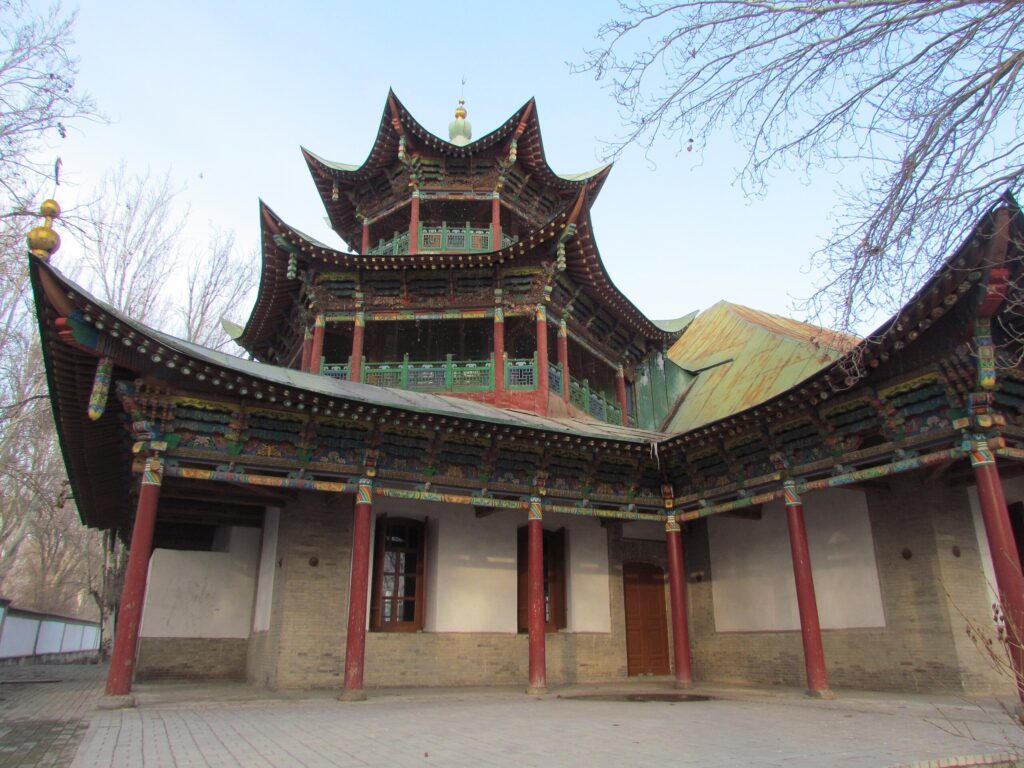
Baikonur Cosmodrome
In the middle of Kazakhstan’s vast steppe lies Baikonur, the world’s first and largest spaceport – and the launchpad for some of humanity’s biggest leaps. This is where Sputnik took off in 1957, and where Yuri Gagarin became the first human in space.
Today, Baikonur is still active, launching rockets to the International Space Station. With the right permit (and a bit of planning), guided tours let you visit historic launch pads, see working control centers, and even watch a rocket lift off – a thunderous, unforgettable experience.
The site blends Soviet legacy, Cold War intrigue, and modern space science – all in one windswept, surreal location.
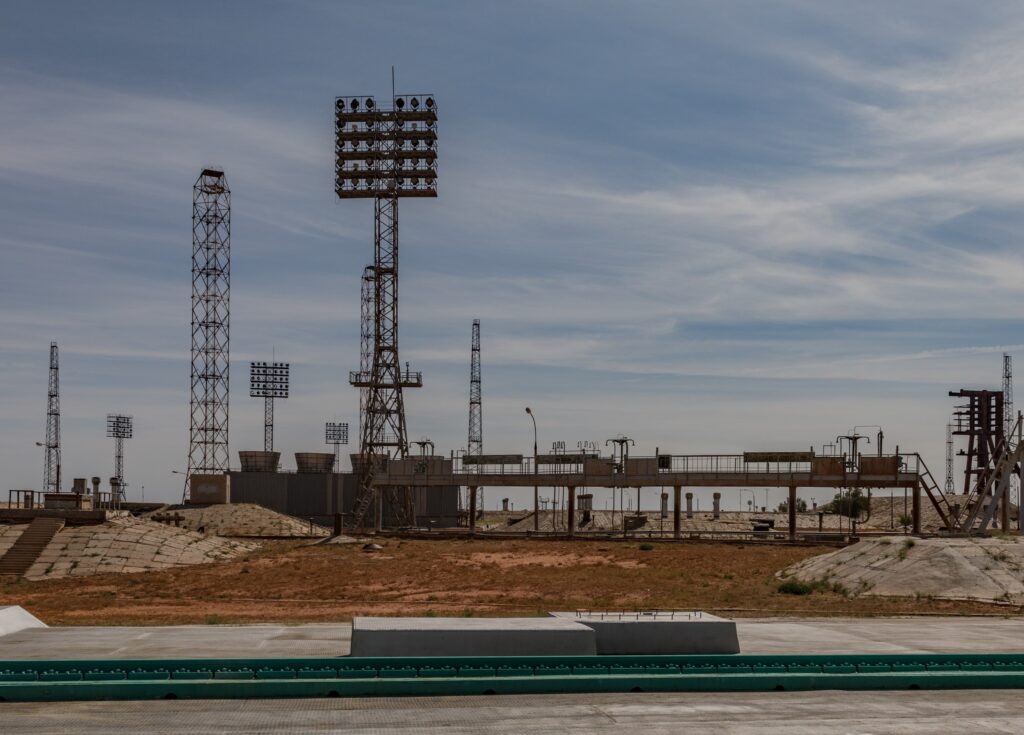
Aksu-Zhabagly Nature Reserve
Tucked into the western Tian Shan Mountains, Aksu-Zhabagly is Kazakhstan’s oldest and one of its most biodiverse nature reserves – a hidden gem for hikers, wildlife lovers, and anyone who craves real wilderness.
This is where you might spot a snow leopard or lynx in the distance, or walk through meadows filled with wild tulips in spring – the ancestors of every tulip on Earth. Eagles soar overhead, bears roam the forests, and over 250 bird species make this a dream for birdwatchers.
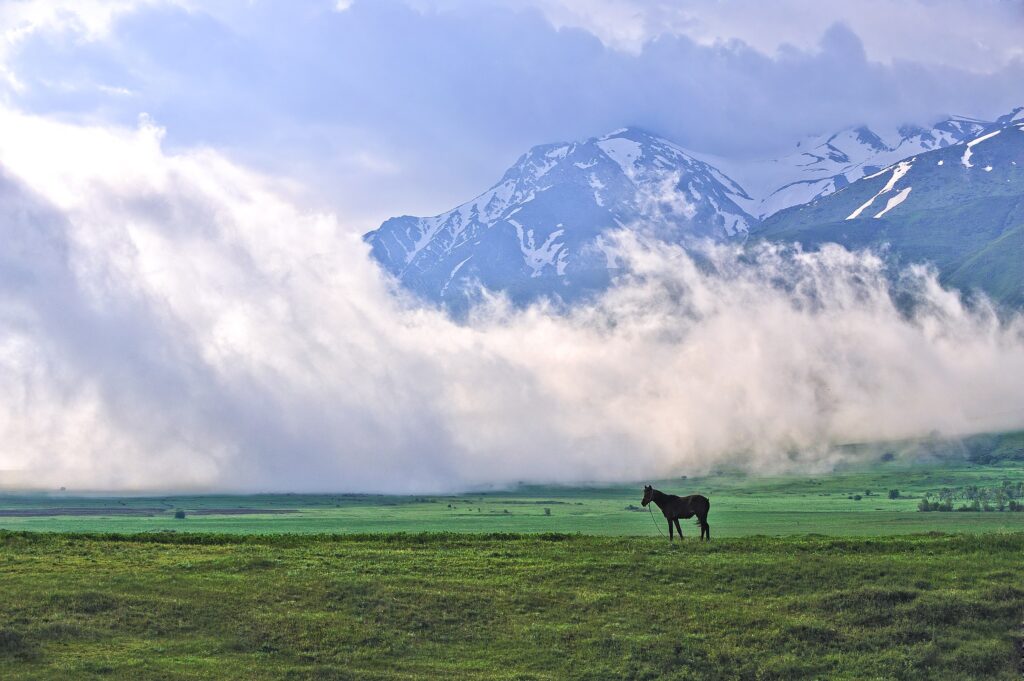
Cultural & Historical Landmarks
Mausoleum of Khoja Ahmed Yasawi (Turkistan)
Rising from the sunbaked plains of Turkistan, the Mausoleum of Khoja Ahmed Yasawi is one of Central Asia’s greatest architectural treasures. Commissioned by Timur in the late 14th century but never fully completed, the structure still stuns with its massive turquoise dome, intricate mosaic tilework, and soaring arched portals.
This is more than a monument – it’s a sacred place, drawing pilgrims from across the region who come to pay respects to Khoja Ahmed Yasawi, the revered Sufi poet and spiritual leader whose teachings shaped Kazakh religious identity.
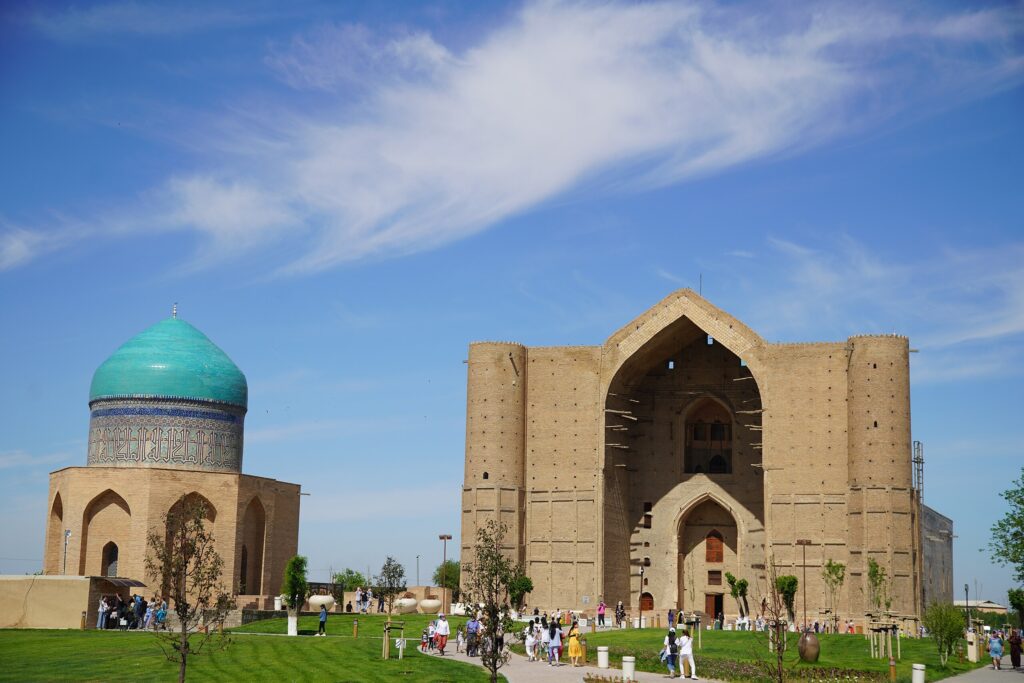
Zenkov Cathedral (Almaty)
Set among the trees of Panfilov Park, the Zenkov Cathedral looks like something from a storybook – painted in soft pastels, crowned with golden domes, and built entirely of wood without a single nail. Even more impressive? It has survived multiple major earthquakes since its completion in 1907.
Inside, you’ll find a richly detailed iconostasis, sunlight filtering through stained glass, and the quiet hum of candles and prayer. It’s still a working Orthodox church, yet welcomes visitors of all backgrounds.
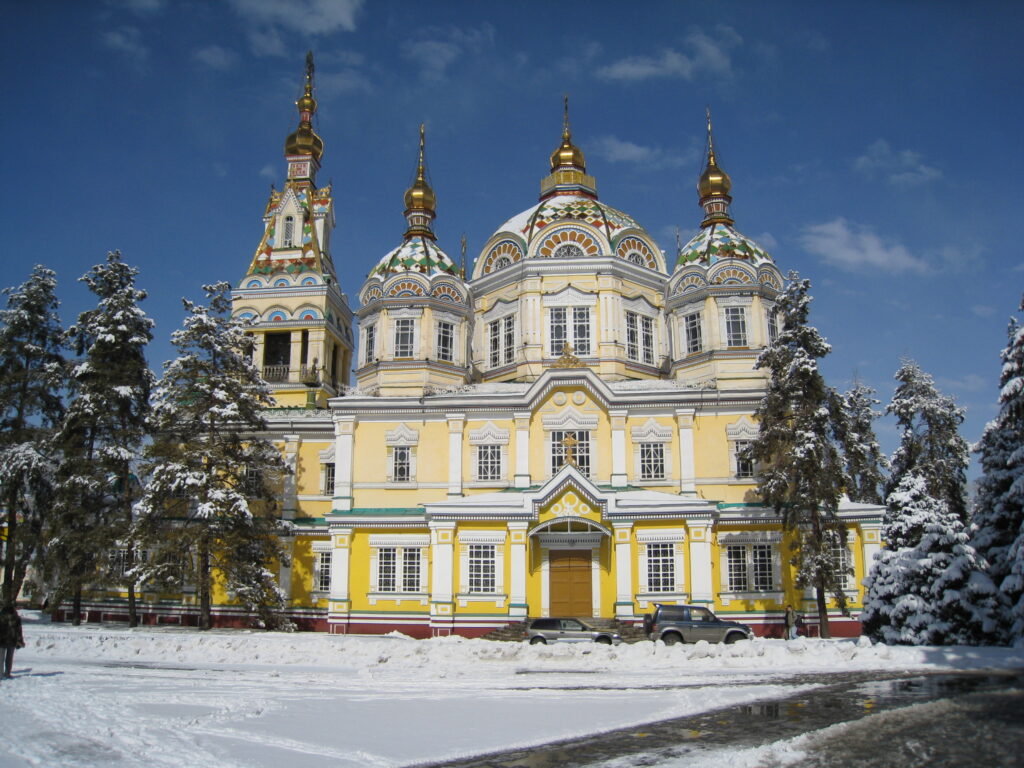
Ethno Villages
Want to time-travel without leaving Kazakhstan? Ethno villages, found near cities like Almaty, Astana, and Turkistan, offer an immersive glimpse into traditional Kazakh nomadic culture – no museum glass, just real experiences.
Spend the night in a cozy felt yurt, learn to cook beshbarmak (the national dish), ride horses across open steppe, or watch a golden eagle soar from its handler’s arm during a hunting demonstration. Local artisans might show you how to weave carpets or play the dombra, the traditional two-stringed instrument.
These villages are built to teach, share, and celebrate — not just perform. You’ll leave with stories, skills, and maybe even a few new friends.
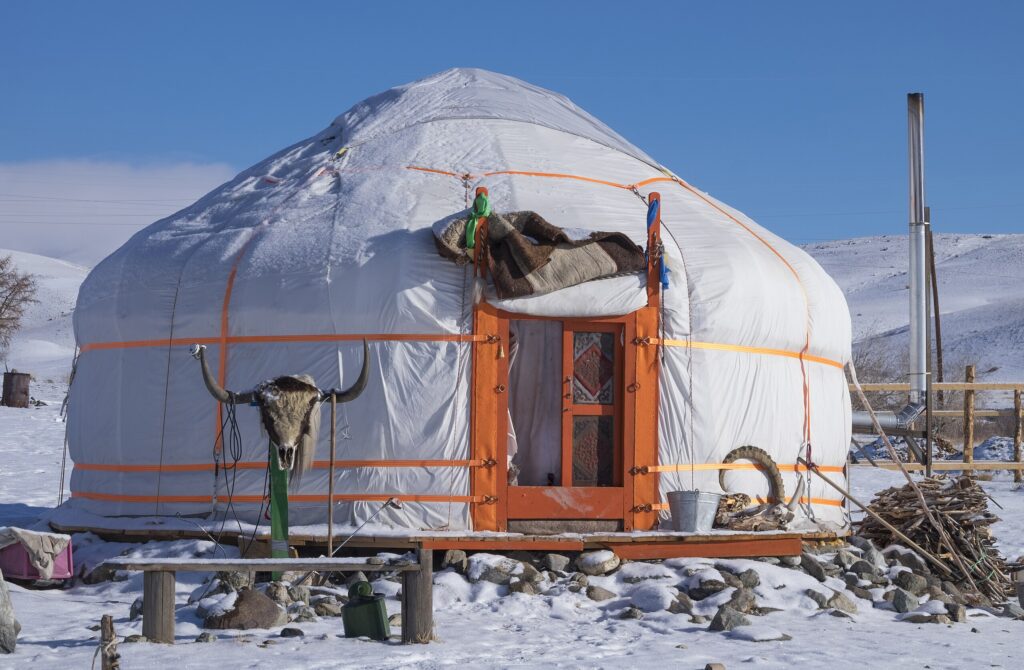
Best Culinary & Market Experiences
Kazakh Dishes You Shouldn’t Miss
Kazakh cuisine is hearty, rooted in nomadic traditions, and full of strong flavors. Here’s what to try when you’re hungry – and curious:
- Beshbarmak – The national dish: tender slices of boiled horse or lamb served over flat noodles in a rich broth. Usually eaten with your hands – hence the name, which means “five fingers.”
- Kazy – A spiced sausage made from horsemeat, traditionally served at celebrations. Dense, flavorful, and deeply tied to Kazakh identity.
- Lagman – A dish borrowed from the Uyghur kitchen: hand-pulled noodles, stir-fried beef or lamb, and vegetables in a savory, peppery broth.
- Baursak – Think fried dough balls that are slightly sweet – best enjoyed fresh, with hot tea.
Traditional Drinks to Try
- Kumis – Lightly alcoholic fermented mare’s milk, slightly sour and refreshing. Often a love-it-or-hate-it taste – try it cold and fresh if you’re curious.
- Shubat – Made from camel’s milk, thicker and creamier than kumis with a stronger flavor.
- Kazakh Tea – A staple of daily life: strong black tea often served with milk, sugar, and a generous spread of sweets, nuts, or baursak. Tea isn’t just a drink here – it’s a ritual.
Markets to Wander & Taste Everything
Kazakhstan’s bazaars are full of smells, textures, and local life – come hungry, and bring cash.
- Green Bazaar (Almaty) – The city’s most famous market. Sample dried fruits, nuts, honey, local cheeses like kurt, and buy heaps of spices, apricots, or herbal teas to take home.
- Sary-Arka Market (Astana) – Less polished but more authentic. A great place to see everyday life, shop for textiles, dried goods, and street snacks, or just people-watch with a cup of tea.
Getting Around Kazakhstan
Transport Options
- Trains – Ideal for long-distance travel. Sleeper cars are clean and comfortable, with views of wide open steppes and mountains.
- Shared taxis & minibuses – Cheap and widely used for intercity travel. Just ask locals or head to the nearest bus station.
- Domestic flights – Airlines like Air Astana and SCAT make it easy to hop between cities like Almaty, Astana, Shymkent, and Aktau.
Driving Tips
- Well-paved highways connect major cities, but roads in remote areas (e.g. Mangystau, Altai, Bozjyra) can be rough or unmarked.
- A 4WD vehicle is recommended for off-the-beaten-path travel.
- You’ll need an International Driving Permit to legally drive as a tourist.
When to Visit Kazakhstan
Kazakhstan’s seasons are extreme, but each one offers something special:
- Spring (April–June) – Wild tulips in bloom, fresh green steppes, and comfortable hiking weather.
- Summer (July–August) – Hot in the lowlands, but perfect for mountain escapes, lakes, and canyons.
- Autumn (September–October) – Crisp air, golden foliage, and great conditions for photography and trekking.
- Winter (December–February) – Cold and snowy, but ideal for skiing near Almaty (Shymbulak) or visiting cities without crowds.
Visas & Entry
- Many nationalities (including EU, UK, USA, and others) can enter visa-free for up to 30 days.
- Others can apply through the Kazakhstan eVisa system — a quick, straightforward online process.
Whether you come for adventure, culture, or serenity, Kazakhstan delivers – generously, quietly, and memorably.

Published July 06, 2025 • 15m to read

